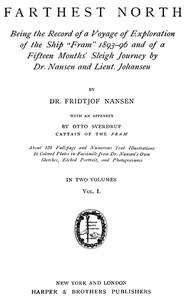Read this ebook for free! No credit card needed, absolutely nothing to pay.
Words: 133233 in 22 pages
This is an ebook sharing website. You can read the uploaded ebooks for free here. No credit cards needed, nothing to pay. If you want to own a digital copy of the ebook, or want to read offline with your favorite ebook-reader, then you can choose to buy and download the ebook.


: Farthest North Vol. I Being the Record of a Voyage of Exploration of the Ship 'Fram' 1893-1896 by Nansen Fridtjof Sverdrup Otto Neumann Contributor - Arctic regions Discovery and exploration; Fram Expedition (1893-1896); Nansen Fridtjof 1861-1930 Travel A
ly dawn; darkness still broods over vast tracts around the Pole.
Our ancestors, the old Vikings, were the first Arctic voyagers. It has been said that their expeditions to the frozen sea were of no moment, as they have left no enduring marks behind them. This, however, is scarcely correct. Just as surely as the whalers of our age, in their persistent struggles with ice and sea, form our outposts of investigation up in the north, so were the old Northmen, with Eric the Red, Leif, and others at their head, the pioneers of the polar expeditions of future generations.
It should be borne in mind that as they were the first ocean navigators, so also were they the first to combat with the ice. Long before other seafaring nations had ever ventured to do more than hug the coast lines, our ancestors had traversed the open seas in all directions, had discovered Iceland and Greenland, and had colonized them. At a later period they discovered America, and did not shrink from making a straight course over the Atlantic Ocean, from Greenland to Norway. Many and many a bout must they have had with the ice along the coasts of Greenland in their open barks, and many a life must have been lost.
And that which impelled them to undertake these expeditions was not the mere love of adventure, though that is, indeed, one of the essential traits of our national character. It was rather the necessity of discovering new countries for the many restless beings that could find no room in Norway. Furthermore, they were stimulated by a real interest for knowledge. Othar, who about 890 resided in England at Alfred's Court, set out on an errand of geographical investigation; or, as he says himself, "he felt an inspiration and a desire to learn, to know, and to demonstrate how far the land stretched towards the north, and if there were any regions inhabited by man northward beyond the desert waste." He lived in the northernmost part of Helgeland, probably at Bjark?i, and sailed round the North Cape and eastward, even to the White Sea.
Adam of Bremen relates of Harald H?rdr?de, "the experienced king of the Northmen," that he undertook a voyage out into the sea towards the north and "explored the expanse of the northern ocean with his ships, but darkness spread over the verge where the world falls away, and he put about barely in time to escape being swallowed in the vast abyss." This was Ginnungagap, the abyss at the world's end. How far he went no one knows, but at all events he deserves recognition as one of the first of the polar navigators that were animated by pure love of knowledge. Naturally, these Northmen were not free from the superstitious ideas about the polar regions prevalent in their times. There, indeed, they placed their Ginnungagap, their Nivlheim, Helheim, and later on Trollebotn; but even these mythical and poetical ideas contained so large a kernel of observation that our fathers may be said to have possessed a remarkably clear conception of the true nature of things. How soberly and correctly they observed may best be seen a couple of hundred years later in Kongespeilet , the most scientific treatise of our ancient literature, where it is said that "as soon as one has traversed the greater part of the wild sea, one comes upon such a huge quantity of ice that nowhere in the whole world has the like been known. Some of the ice is so flat that it looks as if it were frozen on the sea itself; it is from 8 to 10 feet thick, and extends so far out into the sea that it would take a journey of four or more days to reach the land over it. But this ice lies more to the northeast or north, beyond the limits of the land, than to the south and southwest or west....
"This ice is of a wonderful nature. It lies at times quite still, as one would expect, with openings or large fjords in it; but sometimes its movement is so strong and rapid as to equal that of a ship running before the wind, and it drifts against the wind as often as with it."
This is a conception all the more remarkable when viewed in the light of the crude ideas entertained by the rest of the world at that period with regard to foreign climes.
The strength of our people now dwindled away, and centuries elapsed before explorers once more sought the northern seas. Then it was other nations, especially the Dutch and the English, that led the van. The sober observations of the old Northmen were forgotten, and in their stead we meet with repeated instances of the attraction of mankind towards the most fantastic ideas; a tendency of thought that found ample scope in the regions of the north. When the cold proved not to be absolutely deadly, theories flew to the opposite extreme, and marvellous were the erroneous ideas that sprang up and have held their own down to the present day. Over and over again it has been the same--the most natural explanation of phenomena is the very one that men have most shunned; and, if no middle course was to be found, they have rushed to the wildest hypothesis. It is only thus that the belief in an open polar sea could have arisen and held its ground. Though everywhere ice was met with, people maintained that this open sea must lie behind the ice. Thus the belief in an ice-free northeast and northwest passage to the wealth of Cathay or of India, first propounded towards the close of the 15th century, cropped up again and again, only to be again and again refuted. Since the ice barred the southern regions, the way must lie farther north; and finally a passage over the Pole itself was sought for. Wild as these theories were, they have worked for the benefit of mankind; for by their means our knowledge of the earth has been widely extended. Hence we may see that no work done in the service of investigation is ever lost, not even when carried out under false assumptions. England has to thank these chimeras in no small degree for the fact that she has become the mightiest seafaring nation of the world.
But the uncivilized polar tribes, both those that inhabit the Siberian tundras and the Eskimo of North America, had discovered, long before polar expeditions had begun, another and a safer means of traversing these regions--to wit, the sledge, usually drawn by dogs. It was in Siberia that this excellent method of locomotion was first applied to the service of polar exploration. Already in the 17th and 18th centuries the Russians undertook very extensive sledge journeys, and charted the whole of the Siberian coast from the borders of Europe to Bering Strait. And they did not merely travel along the coasts, but crossed the drift-ice itself to the New Siberian Islands, and even north of them. Nowhere, perhaps, have travellers gone through so many sufferings, or evinced so much endurance.
In America, too, the sledge was employed by Englishmen at an early date for the purpose of exploring the shores of the Arctic seas. Sometimes the toboggan or Indian sledge was used, sometimes that of the Eskimo. It was under the able leadership of M'Clintock that sledge journeys attained their highest development. While the Russians had generally travelled with a large number of dogs, and only a few men, the English employed many more men on their expeditions, and their sledges were entirely, or for the most part, drawn by the explorers themselves. Thus in the most energetic attempt ever made to reach high latitudes, Albert Markham's memorable march towards the north from the Alert's winter quarters, there were 33 men who had to draw the sledges, though there were plenty of dogs on board the ship. It would appear, indeed, as if dogs were not held in great estimation by the English.
The American traveller Peary has, however, adopted a totally different method of travelling on the inland ice of Greenland, employing as few men and as many dogs as possible. The great importance of dogs for sledge journeys was clear to me before I undertook my Greenland expedition, and the reason I did not use them then was simply that I was unable to procure any serviceable animals.
A third method may yet be mentioned which has been employed in the Arctic regions--namely, boats and sledges combined. It is said of the old Northmen in the Sagas and in the Kongespeilet, that for days on end they had to drag their boats over the ice in the Greenland sea, in order to reach land. The first in modern times to make use of this means of travelling was Parry, who, in his memorable attempt to reach the Pole in 1827, abandoned his ship and made his way over the drift-ice northward with boats, which he dragged on sledges. He succeeded in attaining the highest latitude that had yet been reached; but here the current carried him to the south more quickly than he could advance against it, and he was obliged to turn back.
Free books android app tbrJar TBR JAR Read Free books online gutenberg
More posts by @FreeBooks

: L'Illustration No. 3732 5 Septembre 1914 by Various - World War 1914-1918; Illustrated periodicals France L'Illustration


: Landmarks in the History of Early Christianity by Lake Kirsopp - Church history Primitive and early church ca. 30-600






